Note that this post contains massive spoilers for Mother 3. I’ll warn you when they’re about to get rotton, but if you want to experience the game clean, you’ve been warned.
 Why is it on this list?
Why is it on this list?
The four preceding games are all “games” first and foremost: yes, there’s a story, heroes that grow, and villains to be defeated, but the primary focus of all of these games is the actual experience of playing the game. In a way, they are a miniscule step up from sports: you can play a game of football, but that game won’t be about something, the best you can hope for is to win, or at least to improve your own skills. Give it a few playthroughs, and nobody cares about Sigma, he’s just the last obstacle before completing the challenge.
This, of course, isn’t to say that there can’t be intricate stories hiding within even the thinnest plots. Super Metroid stars Samus Aran, a woman who, to my knowledge, only speaks “in game” during the introduction of one game out of three, and even that “dialogue” could rearrange a few pronouns to make her a complete mute. In spite of this (or perhaps because of it), even though Samus only had a total of three games between 1986 and 2002, she somehow acquired a number of apparently fan-attributed personality traits. Samus is brave and determined and solitary in her dangerous missions… uh…. like every video game character that stuck around long enough to topple the final boss. Regardless, look at the backlash against Metroid Fusion and Metroid: Other M for sullying the good name of Samus Aran… a character that had previously been little more than a player cipher. The reality is that Samus could either bulldoze everything on Zebes, or cower and never fire a shot to do anything more than defeat a boss or open a door, it was entirely up to the player.
But this is important, and it’s just as much a part of video games as jumping and shooting. More than any other medium, you are the protagonist in nearly every video game ever released. You may relate to Harry Potter, you might admire Schwarzenegger’s latest role, but it’s only in the realm of video games that you so totally inhabit a character. It’s no great surprise, really, as prior to the advent of cinema scenes, you controlled literally every movement of your digital hero for hours, so it’s only natural to feel a close bond with that tubby plumber or little metal boy you’ve been guiding all this time. Who needs virtual reality? We’ve been living it ever since the first person got into the headspace of that long, white paddle (no, it’s not just a vertical rectangle, that’s silly).
So if you get the same feeling from Super Mario Bros., why Mother 3?
Because Mother 3 knows.
For anyone that is reading this site exclusively because they like the sound of my voice in their head, and not because they like video games (hi, Mom!), Mother 3 is the sequel to Earthbound, aka Mother 2. Mother 3, like the rest of the series, was the brainchild of Shigesato Itoi, a name that 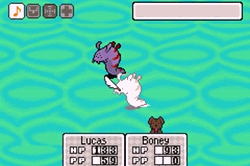 means nothing to most Americans, but a fellow that has made quite a name for himself in Japan as a writer. Like… a for real writer, not someone who had to fill up a cutscene with words so “Over 40 hours of gameplay!” can be stapled onto the back of a box. Hey, I admire you, video game writers, it can’t be easy to get JRPG Protagonist #371 to prattle on about friendship for an entire scene and make it seem fresh (or at least not completely horrible); but Itoi was a writer first and foremost, which is very different from the rest of the video game industry where that skill appears to be valued somewhere below “guy who models armhair”.
means nothing to most Americans, but a fellow that has made quite a name for himself in Japan as a writer. Like… a for real writer, not someone who had to fill up a cutscene with words so “Over 40 hours of gameplay!” can be stapled onto the back of a box. Hey, I admire you, video game writers, it can’t be easy to get JRPG Protagonist #371 to prattle on about friendship for an entire scene and make it seem fresh (or at least not completely horrible); but Itoi was a writer first and foremost, which is very different from the rest of the video game industry where that skill appears to be valued somewhere below “guy who models armhair”.
Itoi started with Mother 1 (and, before I go any further, I want to be clear that I’m not claiming Itoi was solely responsible for these games, as Earthbound in particular was obviously a labor of love for other luminaries in the industry… there’s just an unmistakable tone that runs through all three games, and I find it hard to believe that kind of thing could originate from any more than one dedicated person), a game that was meant to emulate (the big in Japan) Dragon Quest series. It had its fun moments, but it was way too opaque for much of the game, and the charm that would define the following installments was buried under a crushing difficulty. Mind you, this was pretty much standard for JRPGs of the NES era, so whaddya gonna do?
Earthbound, Mother 2, still cribbed heavily from the Dragon Quest series (which, by the SNES era, was becoming about as relevant as Kabuki Quantum Fighter in the West), but anyone willing to deal with its “dated” graphics and gameplay was in for a treat. This was where the meta-elements of the Mother series really came to the forefront, and while it could all be seen as nothing more than silly jokes to a child player, a mature gamer might recognize the variety of components on display that, in their way, mocked the very concept of video games from within a video game. In order to read a sign warning of the dangers of stepping on the grass, you must stand on the grass. A city where everything is the opposite of how it should be proves how a simple switch between 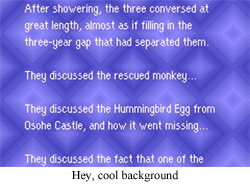 yes and no really means little when you understand what will happen. A village that caged itself in is convinced that their confinement is an illusion and it’s the outside world that is trapped. A statue gets you high, a stone calls to you, and a rock speaks words. I always disparage the thinking that someone “was so high” to create something creative, but the entire game feels like a trip: something just outside reality so you can return and experience life in a new way. Earthbound may reflect the real world, but it is a fantasy first and foremost, and its tone reminds you to just have fun with it.
yes and no really means little when you understand what will happen. A village that caged itself in is convinced that their confinement is an illusion and it’s the outside world that is trapped. A statue gets you high, a stone calls to you, and a rock speaks words. I always disparage the thinking that someone “was so high” to create something creative, but the entire game feels like a trip: something just outside reality so you can return and experience life in a new way. Earthbound may reflect the real world, but it is a fantasy first and foremost, and its tone reminds you to just have fun with it.
Mother 3, though. Mother 3 is reality.
It’s amusing that Mother 3 is the Mother game most based in a fantasy world. Mother 1 & 2 were both set in a modern, suburban environment… albeit one with psychic powers, giant pencil statues, and invading aliens. Mother 3, meanwhile, is tucked into a rural village that has a few modern conveniences at the start, but there’s no reason this couldn’t be some corner of an early Final Fantasy world (or maybe Wild Arms. I do see a cowboy hat). But while the setting is absolutely important to the game, what’s more important are the characters, and, specifically, your character. Yes, you “play as” your entire party (and one mischievous monkey) at one point or another during this game, but the central protagonist, and the number one body you inhabit during this adventure is that of Lucas, a young boy with a mother, father, grandfather, and brother.
This is about where the spoilers get intense…
Family is important. For the lucky ones among us, we grow up with a mother and father and siblings with whom we literally cannot imagine being permanently separated. They’ve always been there, they’ve always been a part of you, and you expect them to be there forever. I apologize if you don’t have anyone in your life like that, and I genuinely hope you find someone, but for many people, family is an integral part of their own sense of self. As one might expect, this is literally impossible to simulate with a video game, or any medium, really, unless you decide to replace an infant’s parents with mascot creatures, which is illegal in Florida as of 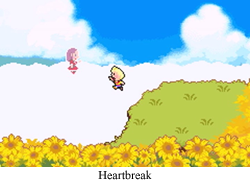 1972 for some reason. As a result, the best any writer can hope for is creating a character that is relatable enough that the revelation that the big bad is secretly hero’s dad will affect you, the viewer, with emotions related to, “Wow, what would it be like if I found out my father was an intergalactic despot?” Family as we consider it is practically a universal experience for human beings (which accounts for 99.9% of all audiences), so those feelings get exploited all over the place. Go buy a Happy Meal™, so you can have a happy family™.
1972 for some reason. As a result, the best any writer can hope for is creating a character that is relatable enough that the revelation that the big bad is secretly hero’s dad will affect you, the viewer, with emotions related to, “Wow, what would it be like if I found out my father was an intergalactic despot?” Family as we consider it is practically a universal experience for human beings (which accounts for 99.9% of all audiences), so those feelings get exploited all over the place. Go buy a Happy Meal™, so you can have a happy family™.
Mother 3’s opening chapter, before you have time to inhabit any of the other characters, features Flint, Lucas’s father, adventuring. He takes up a weapon initially to help with a forest fire started by some invading force, but before the chapter is done, his wife, Lucas’s mother, is killed, and his other son, Lucas’s brother, is lost and presumed dead after he ventures off to avenge his mother. Flint is broken by the loss of his family, and Lucas is left quiet and withdrawn at losing so much at such a young age.
The next few chapters feature a few different relationships, almost all of them between men, and all of them varying degrees of, well, sad. Duster is a an adult still treated like a child by his overbearing and overly proud father, and Salsa the Monkey is clearly just as intelligent and emotionally developed as a human, but he is forced under the yolk of a brutal and abusive master. It’s also telling that during this time you encounter Kumatora, who, despite being a pink-haired princess, is tomboyish beyond reason, possibly making her more traditionally masculine than the rest of the all-male cast. Mother 3, in a subtle way, becomes 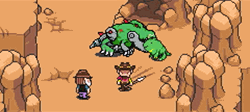 entirely a story about boys and the sins of their fathers… and the absence of their mothers, and, perhaps, a mother’s compassion.
entirely a story about boys and the sins of their fathers… and the absence of their mothers, and, perhaps, a mother’s compassion.
Lucas permanently returns to center stage when Chapter 4 begins, and his life hasn’t improved in the intervening time. His mother is still dead. His brother is still missing and presumed dead. His father is continually absent, searching in vain for his missing son while his present son is ignored. Lucas sets off on his JRPG journey basically because it’s his turn, he’s the main character, and you knew he’d have to round up all the players, gather the macguffins, and fight the evil villain responsible for all this loss eventually. In the end, Lucas, practically a heroic orphan, will save this world and defeat the nefarious despot besetting his homeland.
Except… that’s not going to make anything better.
Mother 3 knows your expectations, and it’s not going to play along.
Lucas’s quest does, evidently, save the world, but the cost along the way is significant. The entire Magyspy tribe, arguably the most helpful and caring people on this planet, are wiped out. The residents may live on, but Lucas’s idyllic hometown is gutted over the course of the quest, and greed, malice, and a general distaste for the elderly are ideas unlikely to vacate their minds just because the big bad is incapacitated. A host of animals are subjected to horrible experiments against their will, and Lucas and company slaughter them en masse for their crimes of being hostile.
And then there’s the finale.
Before I go any further, I want to note that I knew the entire plot of Mother 3 going in. As far as I was concerned, the main “reveal” of Mother 3 was spoiled by Super Smash Bros Brawl’s Subspace Embassy, and, since Mother 3 wasn’t available in English (and it seemed like that day would never come), I finally broke down and read a complete plot synopsis. I read it all, like a novel, with garnished it with detailed descriptions of the characters involved and the tiniest fan theories on what exactly happened when. I knew exactly what was going to happen when I finally played the game, yet still…
The finale of Mother 3 finds Lucas finally reunited with his brother, Claus, but all is not well. Claus has been transformed into a 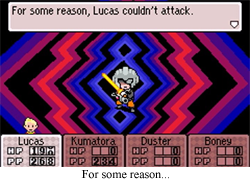 malevolent cyborg by the head villain, and this story ends the only way it could: Lucas and Claus in a one-on-one battle to determine the fate of the world.
malevolent cyborg by the head villain, and this story ends the only way it could: Lucas and Claus in a one-on-one battle to determine the fate of the world.
This is, incidentally, like video game story 101. The final boss is someone important to you/the protagonist, and you’re supposed to whittle down that HP, but maybe not be happy about it? Oh, no matter, there’ll be a solemn cutscene after the battle, and emotions will be released before the gang has to escape a collapsing castle or some such nonsense. Business as usual.
But Mother 3 knows, and it’s not going to make it that easy.
The entire battle is not a battle. Yes, you choose attack, you try to keep your HP up, the usual trappings; but the whole time you are being assaulted not only by magical attacks, but by images of Claus and Lucas together, playing as children, being told stories by their (now lost) mother, and just being brothers. Claus, at this point, is purportedly an emotionless cyborg, but, as the battle goes on, he eases up on the attacks. Is Claus… trying not to hurt his brother?
And then it happens. Lucas is equipped with the Franklin Badge, a defensive item that reflects all lightning attacks. You know this, and thanks to the start of the battle, Claus knows this. Claus and Lucas are both on their last legs, exhausted by the battle, and Claus… uses a lightning attack.
It was at this point that I lunged for the controller in a desperate attempt to “cancel” the badge’s reflection. I failed.
The lightning was reflected, and struck Claus. Claus died. Suicide by brother.
Battle over. Victory. Yay.
Oh, so Mother 3 is a great video game because it’s sad?
Mother 3 is a great video game because it uses the medium to make you care. As I said, I knew what was going to happen. I’d read it all ahead of time, and it was a simple, “yep, that kinda sucks,” at the time I originally learned about this ending. And, to be clear, I’m not the kind of guy that shouts, 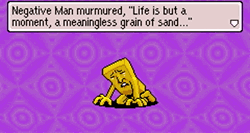 “don’t go in there!” at movies or wastes time delaying the turning of a page when I know some poor protagonist is gonna get it. I’m completely okay with fictional characters biting it, because, come on, we’re attached to these guys, but they’re just imaginary, it sucks, but I’m not building a Dumbledore shrine anytime soon.
“don’t go in there!” at movies or wastes time delaying the turning of a page when I know some poor protagonist is gonna get it. I’m completely okay with fictional characters biting it, because, come on, we’re attached to these guys, but they’re just imaginary, it sucks, but I’m not building a Dumbledore shrine anytime soon.
But Mother 3 is different. It tells a typical video game story, hell, it’s practically Introduction to Hero’s Journey, a trite story telling crutch that appears in roughly 20,000 tales dating back to the invention of the cave. But what it does, how it allows you to so completely inhabit the hero’s head, live in his peaceful village while watching it degrade, and adopt his family as your own; that is only possible as a video game. In no other medium is it possible to hand you, the viewer, control over this boy and his life, and then, during his greatest tragedy, wrest that control away and leave you as helpless as the child watching his family die.
Video games don’t have to be sad to be good, that isn’t the lesson here. The lesson is that video games can make you sad, they can make you feel so many things, and they can do it in a way that would be impossible for novels, movies, or any other way to tell stories. It doesn’t happen every time, and it takes a very deft hand to pull it off, but it’s more possible than it’s ever been. Video games are more than graduated sports, they’re more than trophies and speed runs, they’re more than practice and improvement; video games are love, hate, happiness, and sadness.
Video games are everything, especially when they make you feel like nothing.
The Gaming 5 #5 Mother 3
- System: Gameboy Advance… in Japan. I have a fairly strict “don’t review games I don’t own” policy for the FGC… but this isn’t a FGC entry, now is it? That said, I’m considering the phenomenal Pork Army Survival Guide I own to be a valid substitute in this case.
- Number of players: One lonely boy. Sometimes a monkey.
- “Lunged for the controller”? A keyboard may have been involved.
- Speaking of that final battle: Yes, Itoi has said (and scrapped graphics confirm) that it was originally very different. Maybe it would have involved less lunging.
- Smash Bros ruined the game? Well, not really, but the revelation that Porky returns as an old man (and a statue?) was something that needed an explanation
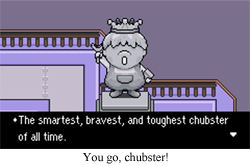 after hungrily devouring Super Smash Bros Brawl. And once I knew the reason for that, I had to know the reasoning behind everything. It’s kind of a shame, though, as I would have liked to have had the experience of playing Mother 3 thinking it was completely divorced from Earthbound, as the game does hide that information until the final chapters (especially considering Porky is known as Pokey on this side of the pond).
after hungrily devouring Super Smash Bros Brawl. And once I knew the reason for that, I had to know the reasoning behind everything. It’s kind of a shame, though, as I would have liked to have had the experience of playing Mother 3 thinking it was completely divorced from Earthbound, as the game does hide that information until the final chapters (especially considering Porky is known as Pokey on this side of the pond). - Favorite Character: He is absolutely horrible, but Fassad has such a depressing backstory that he’s almost endearing. Like, I wouldn’t want to have a beer with the guy, but there’s this subtle story about a weirdo among weirdos finding his only way out is through becoming an absolute monster. I know it’s not going to happen, but if Mother 3 acquired some kind of prequel, he’d be the guy I’d most want to see “before”.
- High Fidelity: I don’t normally note such, but the graphics for this game are so amazing. The last hurrah for the sprites of my youth, and so amazingly brimming with emotion. Mother 3 might be the greatest combination of script and graphics in gaming.
- You didn’t mention Boney once: Boney? Who’s that? Oh, you mean Buster? I mean, come on, if you didn’t name Lucas’s loyal dog after your childhood pet, what kind of monster are you?
- Did you know? Mother 3 was originally going to be a N64 (64DD) game, but it was aborted and eventually ported to the GBA in a completely different graphical format.
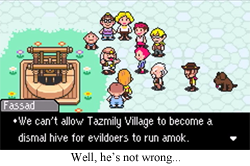 However, if you look at the old screenshots of the cancelled version, you can just about make out the same characters and scenarios from the final version (assuming Ness appears as a placeholder). Except a missing minecart level featuring Lucas and Claus… but nothing was ever lost by dropping a minecart level.
However, if you look at the old screenshots of the cancelled version, you can just about make out the same characters and scenarios from the final version (assuming Ness appears as a placeholder). Except a missing minecart level featuring Lucas and Claus… but nothing was ever lost by dropping a minecart level. - Would I play again: Yeah. Duh. Would be nice to do so on the WiiU, please.
- Gaming 5 Fun Fact: Every game on the Gaming 5 list features at least one character with a mechanical weapon arm. That’s weird, right?
What’s Next? Let’s close out the week with a 2015 Year in Review. Please look forward to it!
[…] judged like art. The best games are the ones that make you feel something, whether that feeling be a deeper appreciation for your family, or a hate for all things furry and clad in t-shirts. Okay, maybe I shouldn’t have used the word […]
[…] because the heroine is rocking an iconic, sentient scarf. In much the same way Psychonauts or even Earthbound is never going to be mistaken for any other title, Stretch Panic establishes itself as singularly […]
[…] an easy example, I cannot imagine Earthbound or Mother 3 working nearly as well as anything but JRPGs. The conventions used and abused in both of those […]